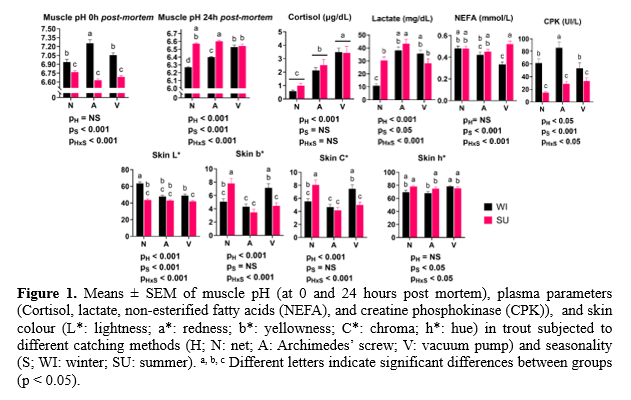ARCHIMEDES’ SCREW HELPS OPTIMIZE FISH CATCHING AND WELFARE
Introduction
Fish used in aquaculture often need to be moved between tanks or sites, especially during the pre-slaughter period. However, the effects of screw pumps vs. suction pumps on welfare and flesh quality are not well understood. Research has indicated that vacuum pumps can cause damage to pelvic fins and increase stress responses in salmonids, potentially leading to higher mortality rates (Espmark et al., 2016). In contrast, the Archimedes screw is considered "fish-friendly" due to the absence of sudden pressure changes and hydraulic shear forces (Þórðarson et al., 2022). An additional factor that has yet to be explored is the interaction between water temperature and the fish’s response to catching methods. This study compared the impacts of two mechanized methods on stress indicators and quality parameters in rainbow trout (Oncorhynchus mykiss) in winter (WI) and summer (SU).
Materials and methods
A total of 240 trout with an average weight of 248.9 ± 46.2 g were captured using nets (N), a screw (A), or a vacuum pump (V), in WI (10°C) and SU (17ºC), ensuring the quickest yet gentlest movements. Less than a minute later, they were stunned using a dry stunning method. In order to assess animal welfare and flesh quality, several plasma parameters were measured (cortisol, lactate, non-esterified fatty acids, and creatine phosphokinase), as well as skin colour, and muscle pH.
Results & Discussion
At 0 hours post-mortem, pH values for A-WI were higher than in all other cases, with values for N and V in WI also higher than those observed in SU, where the metabolic effort appeared to be lower. Increased effort can lead to increased lactate levels and subsequent pH drops (Milligan, 1996). At 24 hours post-mortem, pH levels showed treatment interaction, which was highest for N-SU, while N-WI had the lowest pH. Additionally, A-WI had lower pH than V. This could be due to the higher energy demand of method V, which may result in greater stress. Cortisol levels varied by catching method, with the highest levels observed in V, suggesting that the suction pump may impose higher stress (Þórðarson et al., 2022), followed by A and N. Lactate was influenced by the interaction of catching method and seasonality, with N in WI showing lower levels compared to other groups, reflecting reduced movement due to colder temperatures; while A-SU exhibited higher levels than N and V in SU, suggesting acute effort in A and the hypothesis that method V may impose greater stress, as indicated by its lower lactate levels. NEFA was higher in fish caught with V-SU relative to A and V in WI, however, its levels were lowest for V-WI compared to A-SU and N at both seasons. The consistency in NEFA levels across seasons for N and A suggests a reduced stress response compared to V. The CPK-WI levels were consistently higher than SU across all catching methods due to the slower metabolism, with A-WI showing significantly elevated levels compared to the other cases, highlighting the increased energy demand associated with physical exertion (Liquin et al., 2016) as in lactate. Skin lightness (L*) was higher for N-WI compared to the other cases, and with lower values observed for V-SU than in WI, which could be attributed to higher temperatures during SU or the physical effort required by the catching method during WI (Iger et al., 2001). Higher yellowness (b*) and chroma (C*) values were observed in N-SU and in V-WI, while lower values were found in A in WI and SU and in V-SU. N-WI also had lower b* and C* values compared to SU. These findings suggest that method V may be more stressful than method A, similarly to Erikson & Misimi (2008). Hue (h*) was affected by the interaction, with A in WI showing lower values than N-SU and V-WI, possibly linked to the higher activity associated with this method, suggesting h* as an indicator of trout exertion.
Conclusions
Based on our trial, the Archimedes screw appeared to be more product and welfare friendly than the suction pump for trout harvesting, despite being more demanding a higher metabolic effort. However, it is essential to ensure that water temperatures remain within the optimal range for trout during pumping/movement.
Acknowledgement
Project financed by the MAPA, PISCIBIEN project SPAC/21.
References
1. Þórðarson, G., Steinarsson, A., Bjarnason, Á., & Össurardóttir, Í. B. (2022). Stress of salmonid fishes during pumping. DOI 10.5281/zenodo.6782837
2. Espmark, Å. M. O., Midling, K. Ø., Nilsson, J., & Humborstad, O. B. (2016). Effects of pumping height and repeated pumping in Atlantic salmon Salmo salar. Aquaculture Research, 47, 2088-2096.
3. Milligan, C. L. (1996). Metabolic recovery from exhaustive exercise in rainbow trout. Comparative Biochemistry and Physiology Part A: Physiology, 113(1), 51-60.
4. Liquin, J.I.; Keyong, J.; Mei, L.; Baojie, W.; Longjiang, H.; Mingming, Z.; Lei, W. Low temperature stress on the hematological parameters and HSP gene expression in the turbot Scophthalmus maximus. Chin. J. Oceanol. Limnol. 2016, 34, 430–440.
5. Iger, Y., Abraham, M., Zhang, L., Stoumboudi, M., Alexis, M., Tsangaris, K., Wendelaar Bonga, S., & van Ham, E. (2001). Fish skin alterations as indicators for stress in fresh- and seawater aquaculture. European Aquaculture Society, 29, 109-110.
6. Erikson, U., & Misimi, E. (2008). Atlantic salmon skin and fillet colour changes effected by perimortem handling stress, rigor mortis and ice storage. J Food Sci 73(2):50–59.
